
Electric vehicle sales are growing in India and abroad because of its low operating cost and less harmful impacts on the environment. Till mid June, 6.89 lakhs EVs (including 2W, 3W and 4W) have been sold in India. The main parts in any EV are Battery, Onboard Charger, Inverter, Motor Controller, and, Motor. It is the motor that takes power from the battery to propel the electric vehicle making EV almost noiseless in operation.
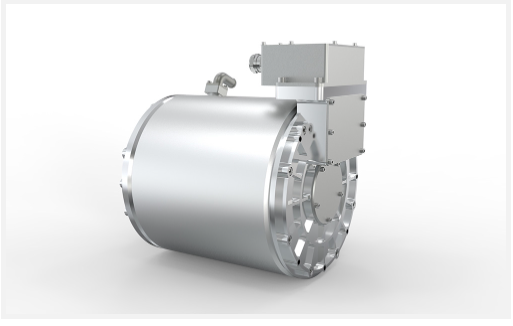 |  |
But how is a motor selected for EV use, is it the same as the motor that is used in our home appliances like motors in water pumps, fans, or in any industries?
The answer is No, because till now for homes and industries mainly Induction motors are used. Electric vehicles are mobile in and dynamic load in nature. An electric vehicle motor has to face wide variation in speed within a few seconds. EV motors have wide operating parameters like temperature, and vibrations. A motor is selected for EV on the basis of following parameters:
- Torque: It is a fundamental parameter of an electric motor that determines its ability to generate rotational force and perform work. It is the measure of the strength of EV that means greater the torque, faster the acceleration vehicle can achieve. It is measured in Newton meters (Nm)
- Power: It is the measure of the rate of doing work. It directly determines the vehicle’s propulsion capability by providing necessary torque. Higher the power the faster is battery discharging. It is measured in watts (kW in case of EV).
- Efficiency: EV motors should be highly efficient as there is limited energy stored in the battery. It should also support regenerative braking.
- Power density: Power available per kilogram of motor weight. Higher power density the smaller and lighter is motor size.
- Robustness: Motor should work efficiently in all conditions and should require easy controllability and should require less maintenance.
Based on these parameters, in EV mainly BLDC, PMSM, SRM (IPM-SynRM) motors are used. Here is the list of type of motors used in EVs
Table of Contents
Type of Motors
Brushless direct current motor (BLDC)
BLDC motor provides good control mechanism, and performance during its operation. It has high efficiency and power density which make it favorable for EV use by reducing losses which ultimately increases the driving range of vehicles. Like a DC motor, BLDC motor consists of two parts in construction- rotor and stator. Rotor is the rotating part of the motor which rotates the vehicle and is made up of permanent magnet. Stator is the stationary part of the motor and is made up of copper winding to create artificial magnet poles by passing current.
There are two types of rotors: outer runner and in-runner. In the outer runner, the rotor is outside and the stator is at the center of the rotor while the rotor is inside the stator rotor.
Working principle: We all know that opposite poles of the magnet attract each other. This same principle is used for operation of BLDC motors. A sensor named hall sensor is attached to the stator (mainly) which senses the position of rotor poles and provides a signal to the motor controller to activate the opposite pole in the stator by supplying current to that particular winding. And this process continues in which the rotor is made to chase the stator winding continuously hence giving rotation to the rotor.
Some important features of BLDC motor are:
- It is compact in size,
- robust due to absence of brush use,
- can offer regenerative braking,
- Have precise speed control and high torque offering make it suitable for EVs
However, it requires a sensor (hall sensor) and its placement on the stator is a precise work.
BLDC motor is used in Hero Electric Vehicles Pvt. Ltd., TVS iQube, Simple One, Bounce Infinity, Jitendra Electric Vehicle, Komaki Electric Pvt. Ltd, Gemopai electric scooters
And BLDC motor manufacturing companies in India – Spark Motors Pvt. Ltd, GoGoA1.com, Rajamane Industries Pvt. Ltd.
Permanent Magnet Synchronous Motor (PMSM)
PMSM is the most widely used motor in electric vehicles due to its high power density, high efficiency, and absence of torque ripple resulting in less noise during operation. Because of the absence of torque ripples, it is even used in four wheelers. PMSM motor is used by Ather (in Ather 450x), Ampere Electric, Tata Nexon, Mahindra XUV 400, MG Comet, and Tata Tiago.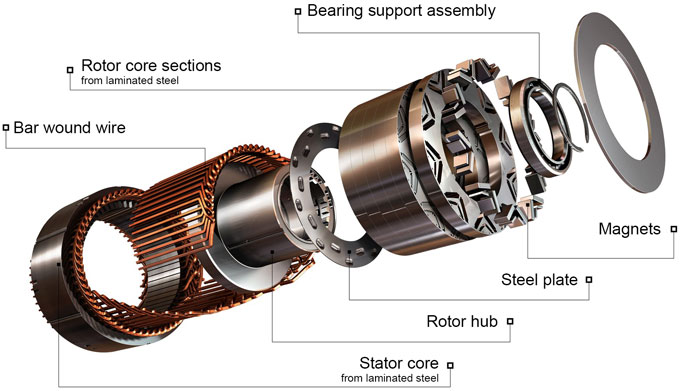
Like the BLDC motor, it has a permanent magnet made of neodymium-boron-iron on the rotor and winding on the stator. PMSM is also classified as Surface- mounted and interior PMSM based on the magnet placed on the rotor. Interior PMSM is more robust and used in high speed applications.
Working principle: PMSM motor is runned by AC source of power not DC like BLDC motor. When three-phase AC power is given to the stator, a rotating magnetic field is produced by the stator. The constant magnetic field produced by the permanent magnet is synchronized with the rotating stator magnet.
Major manufacturing companies: Bonfiglioli, ABB India Pvt. Ltd., Sumit Engineering Works, Narula Electricals.
Synchronous Reluctance Motor (SRM)
It does not require any permanent magnet on its rotor making it cost effective as compared to the motor containing permanent magnet on its rotor. The absence of winding on rotor reduces the copper losses making SRM more efficient than induction motor. The rotor is a simple steel core with salient poles and does not contain any electrical windings.
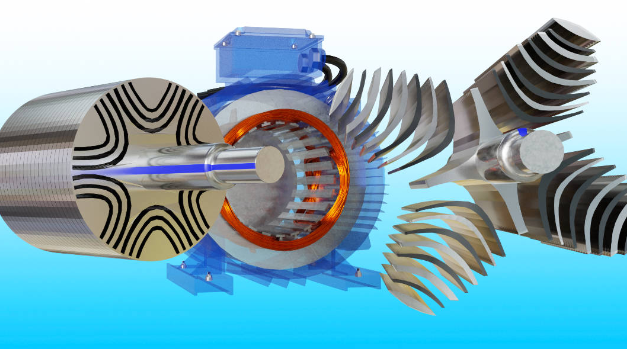
Working principle: It works on the principle of magnetic reluctance. It means that the magnetic flux chooses the path which has least magnetic reluctance. The magnetic flux from the stator takes this least magnetic reluctance path. In this way poles are created in rotors which get interlock with the stator rotating magnetic field. But due the inertia of rotor and hysteresis effects the SRM is not self starting. So, a special electronic circuit is designed to make SRM self-starting. This motor runs at synchronous speed making its use in EVs possible for high speed.
Top OEMs using SRM in EVs- Tesla, Range Rover EV,
Major manufacturing company of SRM Motors: ABB Electric
Read More: Why PMSM and SRM are Used Instead of Traditional or Cost-effective Induction Motors in EVs?
Comparison of BLDC, PMSM, and SRM
| Parameters\ Motor | PMSM | BLDC | SRM |
| Efficiency | Highest | Moderate | Comparatively less |
| Control Mechanism | Complex | Moderate | Moderate |
| Power Density | Highest | Moderate | Moderate |
| Maintenance | Moderate | Moderate | High |

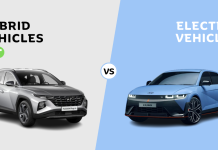
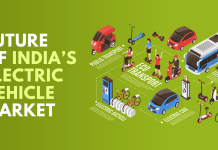
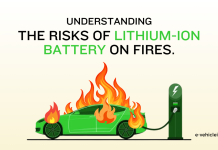



I purchased slow speed hero electric atria lx without Rto and licence for less weight sr citizen73 yrs . BLDC motor used by hero electric Atria.
Please send me more about specification of lithium cells